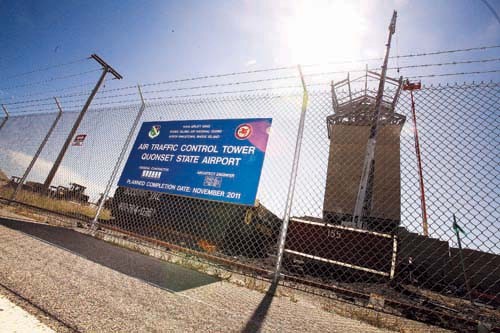
Not long ago, when parachutes arrived at the Rhode Island National Guard’s Camp Fogarty, personnel trucked them among three buildings to inspect, repair and pack them. The setup was strikingly inefficient for the military, known for its standard operating procedures and get-things-done attitude. In November, the process will become far more efficient with the opening of a new $8.9 million airborne equipment facility.
The facility arrives as the National Guard continues a building boom. Since 2006 the Guard has spent $138.5 million – all of it from the federal government – to construct 19 facilities in Rhode Island.
And there is more on the horizon. Work on a $6.3 million air traffic control tower is ongoing at Quonset Air Station in North Kingstown. The Guard also plans a $10 million to $15 million supply warehouse at Camp Fogarty in East Greenwich.
Last year the Guard purchased 133 acres in Burrillville with plans to use the land as a training grounds that should be ready by 2018.
The infusion of money comes when much construction in the private sector has dried up and many areas of government slowed their pace on public infrastructure projects. The Associated General Contractors of America said that private residential-construction spending fell by three-tenths of a percentage point in June compared with the month prior. Public construction spending shrank 9.6 percent since June 2010 and 14.3 percent since March 2009.
The story is different at the National Guard. As the Guard has switched from a reserve force for the country focused on state emergencies to taking on roles in wars in Iraq and Afghanistan, federal money has flowed to the Ocean State.
With it, the Guard has sought to consolidate its systems of armories spread around the state and replace antiquated facilities, many that date to the 1940s and some never designed to last beyond World War II. During the last few years, the Guard has left inadequate facilities in Scituate and Smithfield and is preparing to exit its facility in Woonsocket.
During a tour of Camp Fogarty, Riel and other officers ticked off a long list of new facilities. Besides the parachute repair shop, there’s the 80,000-square-foot combined vehicle maintenance shop that opened in 2009 and replaced repair garages scattered around the state. The 21,629-square-foot East Greenwich Readiness Center opened in 2008 and replaced a 4,000-square-foot facility with just one toilet for men and that was meant to accommodate 209 soldiers (the number it handles today).
At Quonset, a new hangar protects Blackhawk helicopters from the salty air. It replaced a 1940s-era structure where protocol dictated that anyone entering the hangar wear a helmet because engineers were concerned that the glass skylights would collapse at any moment.
All the construction has dramatically changed the image of the National Guard, especially for members who have served decades. Before the recent spate of construction, the last major project the Guard undertook was in 1996. The last big project before that came in 1984 and the one before that in 1962.
“The new kids have no idea how good they’ve got it,” said Lt. Col. Sean McKiernan, construction and facilities management officer for the Guard.
It’s been good too for local contractors. The Guard does not keep formal numbers on the impact of construction, but McKiernan and his fellow officers say they see much of the work going to contractors and subcontractors employing local workers.
McKiernan anticipates more work for contractors in the future. About half the Army Guard buildings are too small for their current use. The Guard’s headquarters in Cranston is one-third the size the Guard would like it. And many buildings lack the technological infrastructure required to support the modern military, said Lt. Col. Kimberly Keller, the Guard’s deputy mission-support group commander.
To undertake future repairs the Guard anticipates leaning heavily on federal money. The federal government will generally pay 100 percent of construction costs for facilities on federally owned bases and that serve troops called to active duty by the president. Depending on the facility, the federal government will also pay up to 75 percent of the maintenance costs; with the remainder coming from the state.
But some projects require a state match to federal dollars. Riel said lawmakers must be cautious as they draft budgets because a cut in a state appropriation for the Guard can jeopardize matching federal money.
“If the state cuts us, we take a double hit,” Riel said.
For the fiscal year ending June 30, 2012, the state has provided the Guard with $3.1 million, down from last year when the state allocated $3.8 million
But the Guard has been especially effective at leveraging federal money through both traditional funding streams and congressional appropriations. The state’s congressmen, especially U.S. Sen. Jack Reed, a Democrat on the Armed Services Committee, have been effective at steering money for construction projects to Rhode Island, officers say.
“It’s quite impressive that our little state … is getting as much support as we are,” Keller said. •












